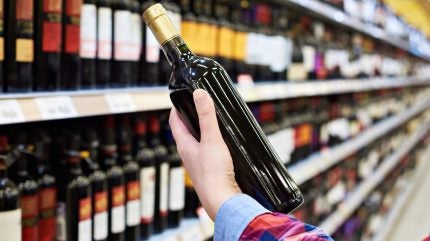
The UK government has shelved plans for restrictions on alcohol advertising but has laid out plans to bring in “mandatory” nutritional and health warning labels.
Last week, the government said it could be assessing “partial restrictions” of alcohol advertising that could be closer to regulations in place for junk food in the country.

Discover B2B Marketing That Performs
Combine business intelligence and editorial excellence to reach engaged professionals across 36 leading media platforms.
A spokesperson for the Department of Health and Social Care said at the time the UK government’s 10 Year Health Plan would “not include a ban on alcohol advertising” but added the Government was “exploring options for partial restrictions to bring it closer in line with the advertising of unhealthy food”.
However, in the 10 Year Health Plan, published today (3 July), a pre-watershed style ban, similar to that in place for foods high in fat, salt and sugar (HFSS), was not mentioned.
Instead, the UK government said it was setting out to “tackle harmful alcohol consumption” with “new standards for alcohol labelling”.
It added it would “strengthen and expand on existing voluntary guidelines for alcohol labelling by introducing a mandatory requirement for alcoholic drinks to display consistent nutritional information and health warning messages”.

US Tariffs are shifting - will you react or anticipate?
Don’t let policy changes catch you off guard. Stay proactive with real-time data and expert analysis.
By GlobalDataHaving obligatory labelling would bring labelling on alcoholic goods “in line” with the labelling used on tobacco, food and alcohol-free drinks products, the Government said. “This will ensure greater public awareness of the health risks of alcohol consumption and help consumers make more informed, healthier choices.”
In 2023, the Republic of Ireland passed legislation which requires alcoholic products to show detailed health warnings on labels. The law is set to come into force in May next year.
Industry response
Miles Beale, the chief executive of the Wine and Spirit Trade Association (WSTA), said the trade body welcomed “the Government’s commitment to tackling harmful consumption of alcohol”.
He added: “The drinks industry already supports the UK’s highly successful voluntary labelling scheme and is keen to work closely with Government on this agenda.
“Industry has a strong record in providing important information for consumers to make healthy choices. Many wine and spirit products already carry calorie information on labels and the majority show units of alcohol, as well as the CMO guidelines.”
Matt Lambert, chief executive of The Portman Group, the self-regulatory body for the alcohol industry in the UK, said the organisation does not believe “there is a case for wider health warning labels”.
Lambert said the labels “may be disproportionate when overall alcohol consumption is falling and the majority of people already drink within the Chief Medical Officer’s low-risk guidance”.
He added: “As the alcohol industry regulatory body for marketing, we ensure that adults who choose to drink have actionable and evidence-based information to make informed choices.
“The vast majority of alcohol products in the UK already carry our best practice standards including pregnancy warnings, unit information, the Chief Medical Officer low-risk drinking guidelines and a link to information from Drinkaware.
“The industry is also making great strides in adding calorie and other nutritional labelling to packaging.”
Low/No threshold
The UK government’s plans also include an intention to launch a consultation on adjusting the upper strength limit for alcohol-free drinks to 0.5% to align with “international standards”.
Reflecting on the move, Laura Willoughby, founder of alcohol-free retailer and bar Club Soda said: “It’s great to see prevention finally front and centre – and no-and-low recognised as part of the solution.
“We welcome the Government’s support for the sector, especially the long-overdue move to fix the descriptors after a decade of consumer confusion.
“We’ll be rallying the UK’s pioneering alcohol-free brands to deliver a strong, united response – and to bring bold, practical ideas to the table.”
The WSTA’s Beale also supported the move, which he said the trade body had “promoted since the last consultation in 2023 and urge them to move fast”.
Lambert added: “We welcome the chance to work with Government to further the uptake of low and no alcohol alternatives as a useful tool to aid moderation and clear up consumer confusion around product descriptors, including raising the alcohol-free threshold in line with our international peers for which we have long-advocated.”
The 10 Year Health Plan also laid out intentions “to explore” ways “to restrict access” of no-and-low-alcohol products by banning sales to underage drinkers.
Far enough?
Others, however, have said the proposed moves do not go far enough to tackle alcohol harm.
Jem Roberts, head of external affairs at the Institute for Alcohol Studies, said: “It’s frankly embarrassing to launch a ‘prevention’ plan that ignores the most effective ways to prevent alcohol harm.”
He stressed the UK government had “dodged proven policies like minimum unit pricing, marketing restrictions, and availability controls”.
“Alcohol is the second biggest cause of death and disability among working-age people. It hits the poorest hardest and drains the economy – costing nearly 180,000 working years in England alone. Prevention doesn’t just save lives, it supports economic growth by boosting productivity and freeing up money currently lost to harm.
“We support clearer labelling but it must be developed independently. The alcohol industry has kept people in the dark for years – and it has no place writing public health policy. If ministers can’t act now, we need a full independent review – like the Khan Review for tobacco – to cut through industry noise and deliver real change.”
Just Drinks has also contacted The British Beer and Pub Association, The Scotch Whisky Association and The Advertising Association for comment.





